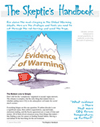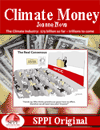|
|
People who have no cheap electricity burn wood or coal inside their homes to make dinner and stay warm. The smoke produces real pollution (as opposed to the fake kind which feeds plants). In India, some homes have pollution levels “three times higher than a typical London street”. Not surprisingly, living in smoke does not work out well for lungs and hearts. “Estimates suggest that household air pollution killed 3·5 to 4 million people in 2010. “
We can argue about the numbers and whether they are exaggerated, but there’s no doubt that millions of people would lead better lives if they had access to cheap electricity, which in practical terms means coal-fired power. In Niger, Africa, 17 million people use less electricity than Dubbo, NSW, a town of 40,000.
Where are the Greens? Children in poverty are suffering from lung damage now. The Greens priority is to spend billions to stop them dying in 2100 from seas rising at 1mm a year. How many people does expensive electricity kill? — Jo
———————————-
Household air pollution puts more than one in three people worldwide at risk of ill health, early death 8.9 out of 10 based on 61 ratings […]
Nothing makes sense about Renewable Energy Targets, except at a “Bumper-Sticker” level. Today the AFR front page suggests* the federal government is shifting to remove the scheme (by closing it to new entrants) rather than just scaling it back. It can’t come a day too soon. Right now, the Greens who care about CO2 emissions should be cheering too. The scheme was designed to promote an industry, not to cut CO2.
UPDATE: Mathias Cormann later says “that the government’s position was to “keep the renewable energy target in place” SMH. Mixed messages indeed.
We’ve been sold the idea that if we subsidize “renewable” energy (which produces less CO2) we’d get a world with lower CO2 emissions. But it ain’t so. The fake “free” market in renewables does not remotely achieve what it was advertised to do — the perverse incentives make the RET good for increasing “renewables” but bad for reducing CO2, and, worse, the more wind power you have, the less CO2 you save. Coal fired electricity is so cheap that doing anything other than making it more efficient is a wildly expensive and inefficient way to reduce CO2. But the Greens hate […]
A new report shows ABC journalists are fond of renewables and overlook their dismal economic value, while putting out bad news on coal, and ignoring the benefits of vast cheap profitable energy. Who could have seen that coming: a large public funded institution attracts employees who like large public funding?
The IPA arranged for a media analysis firm to compare the ABC reporting on coal and renewables.
ABC gives the green light to renewables, and the red light to Australia’s largest export industry and provider of 75% of our electricity.
ABC accused of bias against coalmining
Andrew Fraser, The Australian
The analysis of 2359 reports broadcast on the ABC over six months before March 15 this year found 15.9 per cent of stories on coalmining and 12.1 per cent of those about coal-seam gas mining were favourable, while 53 per cent of those on renewable energy were favourable.
It also found 31.6 per cent of stories on coal mining and 43.6 per cent of stories on coal-seam gas were unfavourable, while only 10.8 per cent of stories on renewable energy were unfavourable.
The ABC has become its own best case for privatizing the ABC. How much could we get? […]
Australia might be the largest coal exporter in the world, but only because all the larger producers of coal keep their own and use it themselves. China is the silent giant coal monster — in 2009 Australia exported 260Mt of coal (our largest export industry). That same year China produced (and used) 3 billion tons. In this era, to predict anything globally, we need to understand China. David Archibald is author of the Twilight of Abundance: Why Life in the 21st Century Will Be Nasty, Brutish, and Short. He slices the energy data. (Energy, of course, drives everything). China is eating through its coal — it may be able to sustain this peak rate for a decade or so. Chinese oil appears close to reaching its peak. Growth in Chinese steel production has been slowing since 2006. The implications are provocative. — Jo
Guest Post by David Archibald
China has become wealthier in the last couple of decades but unfortunately is using some of that new wealth for military adventures against its neighbours. The neighbours aren’t happy. Over 60 percent of the people in countries bordering the South China Sea fear Chinese aggression and expect imminent war. If […]
Oh the dilemma. German Greens have been so “successful” that coal use is rising fast. They helped get rid of the nukes in 2011, punished coal, and subsidized “renewables”. But woe…. energy has to come from somewhere, so the paradoxical crunch comes. Green policies mean that everyone is poorer, but the cheapest energy comes from coal …
The coal industry must be praying for more Green activism:
“IT’S been a black Christmas for green thinkers as Germany, the world leader in rooftop solar and pride of the renewable energy revolution has confirmed its rapid return to coal.
After scrapping nuclear power, Germany’s carbon dioxide emissions are back on the rise as the country clamours to reopen some of the dirtiest brown coalmines that have been closed since the reunification of east and west. The Australian
Though some say the problem is “carbon credits” are too cheap. (We need to be poorer?)
“…new figures show that coal power output in 2013 reached its highest level in more than 20 years. Researchers blame cheap CO2 emissions permits, and demand urgent reforms.
The stats: Germany is using almost as much coal as it did in 1990:
In 1990, Germany’s brown coal-fired […]
Bill McKibben wants to stop a mine in Australia because it might affect the weather. He says wind power is as affordable as coal.
The Australian, Friday Oct 25: “… we’ve reached the point where alternatives have become realistic.Wind power is now as affordable as coal-fired power in Australia, not to mention the limitless energy potential of the powerful sun that shines on your continent.”
To which I say, fantastic. If wind power is as cheap as coal, we don’t need a carbon tax, emissions trading schemes, renewable targets, or other subsidies … people will use wind simply because it is cheaper. Alternatively, Bill is talking out of his hat.
Kill the schemes, cut the subsidies. Bring it on. I say!
We can see how many people rely on Windpower in Australia
That’s the yellow part. Coal is the black or brown part.
Source: ESAA
Source: ESAA
All the assertions of “cheap wind power” are only true if we assume our CO2 emissions cause warming, amplified by water vapor and cloud changes, which causes dangerous and expensive outcomes. Furthermore we must assume that it is cheaper to mitigate rather than adapt (which it isn’t), and then assume that taxes, […]
Rudd has a chance to dump a dumb policy, but won’t
Australia’s overpriced, unneccessary carbon tax will become even more overpriced next Monday (from $23 to $24.15 per ton). A spokesman tells The Australian that the all-new Labor cabinet will reconsider it all next week and may bring in the trading scheme sooner rather than later. At the moment the Gillard-fixed-carbon-price will shift to a floating price (lately, a sinking price) in two years time in mid 2015. The current EU price is $6 AUD.
The Australian understands Mr Rudd will look at all aspects of the implementation of the $23 a tonne price on carbon as a priority. The reinstated Prime Minister sought to cement his commitment to tackling climate change, declaring he had “long been committed to a carbon price”.
Rudd mistakes token efforts in China for “action”:
He accused the Coalition of inconsistency on the issue and cited action in China as evidence “carbon pricing is now becoming more and more of a global reality”.
The real global reality and action in China is that it is building more coal powered stations than anywhere, and is one of the largest coal burning nations in the world. China […]
If the Greens cared about CO2 they’d be very interested in ways to reduce emissions. But their selective interest speaks volumes about their real priorities. Anton Lang shows how newer coal fired powers stations run hotter and at higher pressures, and use 15% less coal to produce the same amount of electricity. We could upgrade our power stations and cut a whopping 15% of their emissions — which is huge compared to the piddling small, often unmeasureable savings thanks to renewables. Even massive floods that stop industry don’t reduce our emissions as much as this would. Do the Greens hate the coal industry more than “carbon pollution”? — Jo
———————————————————–
Ultra Super Critical Coal Fired Power gives a 15% CO2 Emissions Reduction
Guest Post: Anton Lang (aka TonyfromOz)
It all comes down to steam.
Assume (for a moment) that we have to reduce the emissions of CO2 by something like 20% between now and 2020.
Previously I showed we could achieve a reduction of 13% in CO2 emissions from the electrical power generating sector just by converting from the current 70’s technology coal fired power to the newest technology USC (UltraSuperCritical) coal fired technology. That 13% I quoted […]
Coal power provides most of our electricity and despite widespread floods these plants have to keep working day in and day out to provide our baseload power. | This one above is the old decommissioned “New Farm” Coal Power Station (1942) | Queensland State Library
Anton Lang cuts the numbers, and finds that while the Australian floods cut power consumption by 9% on the Eastern seaboard they only reduced CO2 emissions by 0.9%.
Even if cutting CO2 emissions was useful, it’s much much harder than most people realize. Electricity use is so pervasive that even though whole towns were off-the-grid due to floods, and real consumption fell, it didn’t make any difference to emissions. That’s because the baseload consumption is still so high, and is mostly still a coal powered load. Reducing the peak use of electricity by a whopping 9% hardly makes any difference to the total daily curve of electricity demand. The electricity for the peak load comes from natural gas, a bit from hydro, and some from intermittent unpredictable renewables. Coal can’t be switched up and down quickly, and it isn’t efficient to do so, even if it were possible to ramp up or change the […]
Guest post by Anton Lang (TonyfromOz)
(Thanks to ianl8888 for bringing this map from Tallbloke’s site to my attention)
This is a map of projected coal fired power plants that have been approved for construction. The map tells us a lot about the Kyoto Protocol, and more specifically, just how much clout does the UN really have.
Some parts of the world are increasing their coal fired electricity faster than others (Click to enlarge).
Source: Figures come from this World Resources Institute Report. (Nov 2012) Graphic? author unknown.
Kyoto was adopted in 1997, and so far, 195 Member Countries have signed up to it with that first signature. All but a couple of countries then added that all important second signature ratifying it, meaning that they were bound by what Kyoto asked for, a reduction of CO2 emissions to a level 5% lower than what they were in 1990. In 2007, Rudd added that second signature on behalf of Australia, leaving the U.S. as the only country not to ratify the Protocol. Some countries have said that they will not ratify any rehash of Kyoto, which expired at the end of last year. Only 24 […]
A joint writing project: Jo Nova & Tony Cox,
based on an idea and research by Anton Lang (who writes as TonyfromOz at PAPundits)
It’s the paradox that will torture the Greens. What if the best way to achieve their environmental aims as well as providing jobs and power was to build more coal fired power stations? Imagine if we could reduce CO2 emissions by more than 5%, supply 24 hour baseload electricity, create jobs, and save thousands of square kilometres of Australian bush from industrial domination. Imagine if “New Coal” turned out to be the lowest cost alternative as well? Anton Lang has researched it, and Tony Cox has confirmed that the big numbers make sense with an Australian electricity company (who shall not be named). Selling the Carbon Tax in Neverland is already a public debate that’s pretzel tied in impossible contradictions, so what’s one more unlikely twist? Possibly, just enough to get us out of a knot, or at least enough to expose the real aims of the carbon reduction plan. Old existing large scale coal fired power plants in Australia are all twenty to forty years old. Major advances […]
UPDATE: It appears ANZ is not feeling apologetic or likely to cave in to green threats. ANZ chief executive Mike Smith, has delivered a savage attack on Julia Gillard, declaring her party was part of the “weak government club” of the world.
Greenpeace have produced a hit job on the ANZ Bank: a (fairly) slick production designed to seriously hurt the bank’s brand name, and to make it harder for coal miners to raise funds (which ultimately makes it harder for the poorest in society to pay their electricity bills).
This is why I insist: Yes, this IS about the science. Even if we defeat the tax and trading scheme, as long as the public think “carbon is pollution” any honest business or business working with them will be subject to this bullying. Coal provides about three quarters of all Australian electricity. Yes, we need to get rid of the pollutants in coal production, but carbon dioxide is not one of them.
We are carbon life forms. There is no evidence that the climate models are right, and that CO2 emissions hurt the planet. Greenpeace could attack the coal industry because of poor safety standards, or because of […]
Greg Combet (our Minister for keeping-the-weather-the-same) can keep a straight face when he tells coal miners that their jobs are protected with him. You might think that’s insane, (especially if you are Green) but he has a point. Even if carbon mattered, our coal exports do not. (Not that Combet seems to explain this point very well, he seems to think people won’t notice the contradiction about supposedly “making the big polluters pay”, even though he’s taxing mom-and-dad and partly-exempting Big-Coal).
Australia is the worlds largest exporter of coal, you’d think our production mattered. But Combet knows that it makes no difference at all to the environment if we dig masses of coal up and send it to the Chinese to burn. Australia might have lots of coal, but it earned the ‘biggest exporter” title only because lots of the other contenders forfeited. Basically, we only win because there are not many people living here. Other places dig up a lot more coal, but coal is so handy, vital, and irreplaceable that they keep every last sodding bit, burn it all themselves and have none left over to sell.
Australia sold about $55 billion dollars worth of coal in 08/09, […]
|
JoNova A science presenter, writer, speaker & former TV host; author of The Skeptic's Handbook (over 200,000 copies distributed & available in 15 languages).

Jo appreciates your support to help her keep doing what she does. This blog is funded by donations. Thanks!


 Follow Jo's Tweets
Follow Jo's Tweets To report "lost" comments or defamatory and offensive remarks, email the moderators at: support.jonova AT proton.me
Statistics
The nerds have the numbers on precious metals investments on the ASX
|












Recent Comments